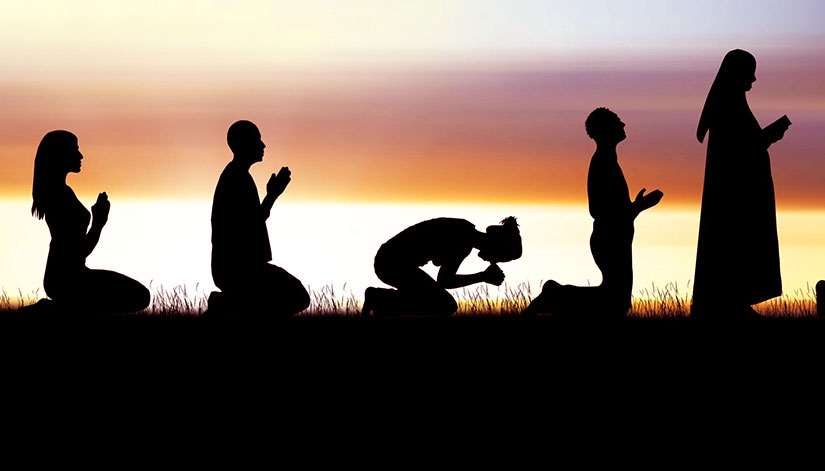A partial or complete abstinence from any kind of food is called fasting. People do it all the time to lose weight, to stay healthy or detox their bodies. However, fasting holds a cultural significance for a lot of religions as well, including Hinduism, Islam, Christianity, Jainism, and Buddhism. A couple of hours or even several weeks can pass during a fast, at which time individuals often eat after nightfall.
It’s interesting to note that fasting is not just a simple way to lose weight for the population. People of various faiths fast independently in their own way, and sometimes even within the same religion. While Coptic Christians in Egypt fast for various lengths of time for 210 days a year, Catholics abstain from meat only Fridays during the time of Lent. There are even some societies that fast for purposes, unrelated to religion. The “Fast of Geneva,” also known as the “Jeune Genevois,” is an official holiday that takes place in September and people fast on this day. Its roots can be traced back to the Middle Ages, when formal periods of fasting were set aside as acts of penitence following tragedies like wars, and epidemics. Thus, Fasting has been a part of many nations’ traditions for many years and is likely to remain so in the years to come. One should always respect the cultural customs of those who fast.
Needless to add, fasting is a great medical tool to keep your health in proper shape, even though religious fasting is primarily carried out to fulfil obligations of faith. It is a type of dietary model that differs in the amount of calories restricted and the foods abstained from. Westerners typically have diets that are heavy in animal-based meals and low in plant-based foods, which is bad for health. According to earlier research, such heavy carb eating is associated with both type 2 diabetes and early death. Meat also has the greatest impact on land usage and greenhouse gas emissions; for example, a 1,000 kcal of beef produces almost over 10kgs GHG emissions.
So if we decrease our meat intake, it can reduce such emissions and have a good impact on overall population health. In a way, one can say that religious fasting may benefit the world, society, and human health overall everywhere.
Various Cultures and their way of Fasting:
Millions of people around the world observe fasting traditions as dictated by their religion. Almost 80% of people identified themselves as religious in a poll conducted back in 2010. Fasting is an essential practice that confers not just health but also spiritual benefits for the man. In fact, fasting affects the community’s well-being and a sense of belonging as well as planetary wellbeing, in addition to the personal sense of wellbeing which means a harmonious mind and a strong body.
Hence nations with a higher percentage of citizens who identify as religious, face greater environmental dangers and are less equipped to handle it.
Every religion performs fasting in their own way. Come, let’s have a look at it.
Baháʼí Faith:
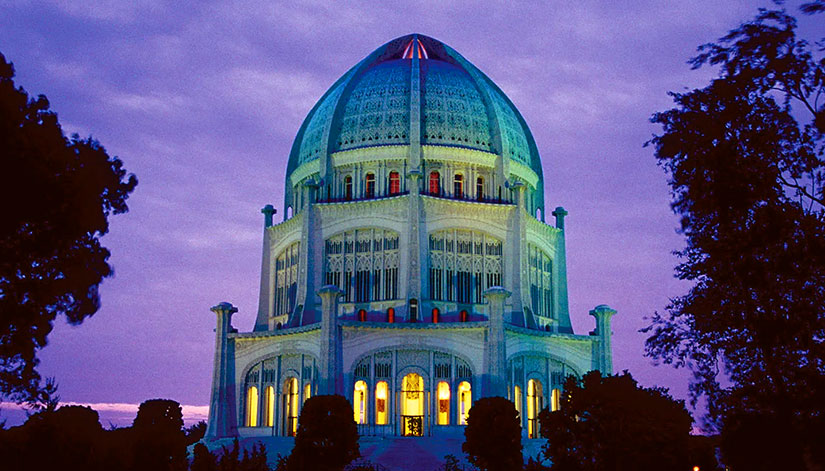
Throughout the Bahá’í month of ʻAla’, which is March 1st to 20th, abstinence from eating is practised in this faith between sunrise and sunset. The principles in the Kitáb-i-Aqdas ask for the total abstinence from every kind of beverage or food during the day and no smoking either. However, prescription drugs are allowed. This fasting is observed by all between the age of 15 to 70, apart from those who are unwell, pregnant, or menstruating. People whose jobs require lengthy hours of work, and who are extremely ill, are among the exceptions to the fasting rule, and have to eat alone, in private.
It is one of the most important duties of a Bahá’í, along with the mandatory prayer. A believer must endeavour to make the readjustments in his life and to revitalize the divine energies that have been lying dormant in his soul during this time of spiritual recuperation. To them, Fasting serves as a reminder to abstain from sensual and self-serving cravings, and live a noble life.
Buddhism:

Buddha once said while travelling through the Kasi region, that when he goes without food, it is because he is conscious about his health, and that one should always refrain from eating after nightfall. That is the only way one can truly be aware of the benefits of a comfortable illness-free life.
Buddhists who adhere to the Vinaya norms, typically abstain from eating after midday, every day. This is their restricted routine that they follow everyday to promote good health and relaxation rather than a fast.
Buddhists fast while they are engaged in intense meditation. While they permit the drinking of milk, they usually refrain from all animal products. They also do not eat processed foods and items high in sulphur, like garlic. They use the phrase “Middle Path” which means to stay away from both extremes of self-loathing and hedonism. Buddhists are commanded to fulfil all eight precepts, like abstaining from noon till the next morning, on Uposatha days, which happens once every seven days. The commandments remain unchanged, and also dealing with money is forbidden.
Christianity:

Many of the Christian faith practice fasting, which can be done alone or as a group during specific liturgical seasons when a believer feels guided by the Holy Spirit. A lot of Christians also stop eating before the Communion, and it is called the Eucharistic Fast.
In the first century A.D., the sermons of the Twelve Apostles instructed the Christians to observe their fast on Wednesdays to remember Judas’ betrayal of Christ and also on Fridays to grieve Jesus’ crucifixion. Hence, Friday is a day of abstention from dairy products, meat, and alcohol. It has been observed historically by the Catholic, Orthodox, Methodist, and Anglican sects of Christianity.
The Bible says to fast for forty days and prayer along with it, which served as the inspiration for the creation of the liturgical season of Lent. According to the Old Testament, before receiving the Ten Commandments, Moses travelled into the mountains which took about forty days “without eating bread or drinking water”. Same is the story of the prophet Elijah, who travelled up into the highlands to fast and pray, and it was there that “the word of the Lord came to him”. According to the New Testament, Satan tried to lure Jesus when he was praying in the desert for the same time period. Moses, Elijah, and Jesus are all said to have fasted for a full forty days and nights in preparation for their ministry, and their example laid the groundwork for the formation of Lent.
Many members of the Catholic Church, Lutheran Church, Anglican, Methodist, Western Orthodox, and United Protestant Church, and also Reformed Church observe fasts during this forty-day “Lent” season in remembrance of the fast that Christ observed during his temptation in the desert. Some Western Christians fast for the entire Lent time period, while others prioritise Ash Wednesday and Good Friday as the traditional fasting days during Lent. In the Ethiopian Orthodox Church, there are seasons of the year when people observe partial fasts, which involve going weeks without eating or drinking milk or meat. Some congregations, such as Catholic, and Baptist, observe the Daniel Fast all through Lent.
There’s also the Black Fast, where you have to refrain from eating anything throughout the day until dusk, when they break the fast. Mostly Christians in India and Pakistan still observe the Black Fast on Ash Wednesday and Good Friday; some even go without food the entire Lenten season. A communal Lenten lunch, hosted in the parish hall of the church, is the customary way for Christians to break their Lenten fast together after attending a worship service, and it happens usually on Wednesday evenings.
Hinduism:

In the book of Mahabharata, Yudhishthira asks, “What is the highest, most beneficial” and fruitful “of all kinds of fasts in the world?” Fasting usually happens on the 12th of the lunar month, as a yearly devotion to Krishna.
Hindus have a widespread variety of fasting as per their personal beliefs and faiths. Certain Hindu days, like Ekadasi, or Purnima, are observed by some as days of fasting. Based on a person’s personal beliefs and preferred deity, there are also specific days of the week designated for fasting. Devotees of Shiva, for instance, typically fast on Mondays, whereas those of Vishnu and Ayyappa typically fast on Thursdays and Saturdays, respectively.
The Hindus of North India often fast on Thursdays. Fasters additionally worship Vrihaspati Mahadeva on Thursdays. Before breaking their fast, devotees listen to a story and they usually like meals coloured yellow, and they also dress in yellow. Ghee, which is yellow in colour, is used to make food. The banana tree is watered and worshipped by women. Many Hindus who follow a guru will fast on Thursday as well. There are religious holidays as well. Typical instances include Maha Shivaratri, when most people observe a rigorous fast on this day, not even drinking any water, or the nine days of fasting for Navratri, which fall twice a year in April and October/November, right around Vijayadashami and before Diwali.
Northwestern and southern India both have a widespread practice of fasting on Tuesdays. Goddess Mariamman, a manifestation of Goddess Shakti, is worshipped on Tuesdays, according to South-Indian belief. Prior to sunrise, devotees consume food, and from sunrise to sunset, they only consume liquids. Devotees of Lord Hanuman are only permitted to eat milk and fruit between sunrise and sunset on Tuesdays and Saturdays, which are dedicated to him. They also do half-day fasting by consuming only liquids during a set time, such as water fasting.
There is also a custom where married women in certain regions of India observe Karwa Chauth, a type of fasting, in hopes of promoting their husbands’ health, wealth, and longevity. Many Hindus also celebrate Shraavana in the fifth month of the calendar, known as Shravan Maas. Women also fast frequently during the month of Kartik, which starts the day after Diwali.
Fasting techniques also differ greatly among different sects of the religion. When fasting is adhered to religiously, the fasting individual does not consume anything shortly after the previous day’s sunset till 48 minutes following the sunrise of the subsequent day. Fasting can also entail avoiding only particular kinds of food, like only dairy products and not any other kind of animal products. In the western region of India, popular fasting foods include sabudana, and khichadi.
Jainism:
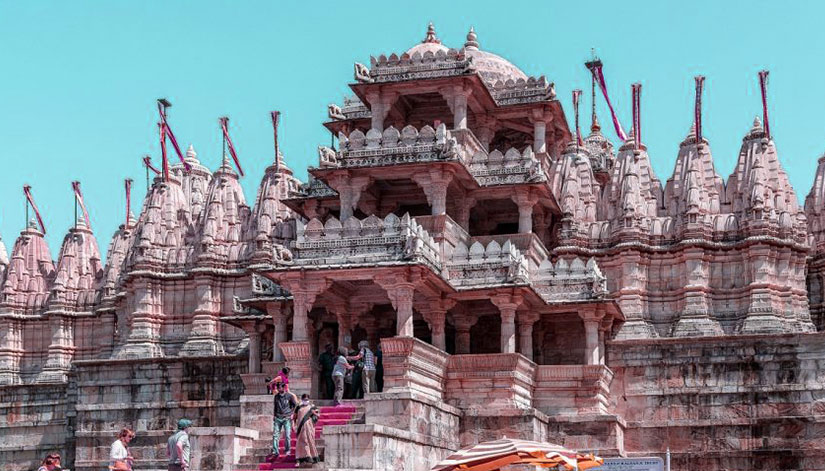
Jains fast frequently and also during special occasions. On important occasions like birthdays, and festivals, or even holy days, the majority of Jains fast.
For Jains, the majority of religious practices are observed during the monsoon season. The most important event is Paryushan, which takes place when the monsoons arrive and lasts eight days in Svetambara Jain custom but ten days in Digambar Jain. But a Jain can observe fasts whenever he wishes. Occasionally, Jain saints can also feel compelled to fast, after they may have erred in their interpretation of Mahavira’s teachings. Fasts vary, and Jains are encouraged to do their best to maintain whatever level of self control each person is capable of. As stated in their sacred texts, Jains should always abstain from over-indulging their five senses, which they call “upavasa”.
Sikhism:
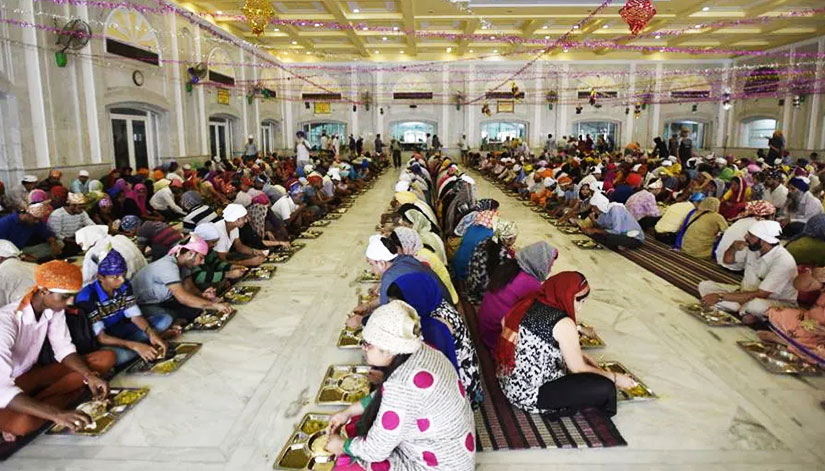
Fasting is not considered a spiritual practice in Sikhism; in fact, it is discouraged if it is being done for austerity or as a way to mortify the body through willful hunger. Sikhism promotes moderation and temperance in eating habits, which means you must not starve yourself, nor should you over-indulge. Fasting is not encouraged unless it is absolutely necessary for health.
Sikh Gurus believe that fasting does not bring any spiritual benefits, so thy discourage devotees from fasting; and those who do, are rewarded with nothing but a shell, according to the holy text of Guru Granth Sahib.
In the words of Guru Sahib Ji, “Goal of humans is to meet the Lord-groom. One who discards this grain, is practising hypocrisy. She is neither a happy soul-bride, nor a widow. Those who claim in this world that they live on milk alone, secretly eat whole loads of food. Without this grain, time does not pass in peace. Forsaking this grain, one does not meet the Lord of the World.”
Taoism:

Originally a Daoist method for turning into a “Xian”, meaning immortal, one should avoid all foods- hence, fasting was later used as a traditional Chinese medical treatment for the bad spirits residing in the man’s body, that may shorten his life span. From not eating certain products like grains, to not eating anything, the Chinese believe that to achieve greatness of spirit, one needs to learn to stay alive without taking any nourishment.
Chinese interpretations of avoiding “Gu” (grains) or fasting have changed over time, but Taoism remains as the idea that all living beings on earth should try to live in a harmonious balance with the universe, “Tao”. Believers of this faith try to attain spiritual immortality, so that their soul may join the divine universe after death.
Judaism:

For Jews, fasting entails giving up on all food, including water. They usually fast six days a year. Fasting is not allowed on Shabbat, except on Yom Kippur. This is because the biblical commandment to observe Shabbat takes precedence over the fast days that were later implemented by the rabbis. The Shabbat can also be superseded by the Tenth of Tevet minor fast, but with the current calendar, that won’t be happening anytime soon.
Yom Kippur is regarded as the most significant day in the Jewish year, where all Jewish men and women over the age of their bar/bat mitzvah are expected to fast on this day as a sign of repentance. The Torah only makes reference to this one day for fasting.
Since jeopardising a life is against the fundamental Jewish principle, only the sick or fragile are excused from the fast. In fact, they are not allowed to fast at all, ever. When it comes to eating on this day, people are advised to avoid overindulging and to eat not much at a single sitting. Also even if one does not eat while lying in bed at home, they are still regarded as having attended the entire spiritual service.
Tisha B’Av is the second major day of Jewish fasting. It is observed on the day when the Babylonians desecrated the first Holy Temple of Jerusalem, 2500 years ago, and then when the Romans annihilated the second Holy Temple almost 2000 years ago. Tisha B’Av was the one day on which they were permitted to fast, following the Kokhba revolt, at a time when their ancestors were banished from their own homeland. After a period of three weeks of grieving that started with the 17th of Tammuz fast, Tisha B’Av draws to an end. So on this day, fasting Jews also pay tribute to the countless tragedies that have befallen the Jews, and that also includes the Holocaust.
Jews fast from sunrise to sunset primarily, and there is more forgiveness if a sick or feeble person, or a woman who is pregnant or nursing, finds the fast to be too difficult. There are also four minor public fast days, like the Gedaliah Fast, observed the day following the Rosh Hashanah, the Fast of the 10th of Tevet, the Fast on the 17th of Tammuz and the Esther Fast, which falls on the day before Purim.
Jews can practise individual or group fasts outside of these designated fasting days, in an effort to find atonement to face a tragedy or a forthcoming disaster. For example, dropping a sefer Torah can occasionally result in a fast. The day preceding Passover, only first-born sons are required to observe the Fast of the Firstborn. This duty can be circumvented by partaking in a ritual meal known as “siyum”, which takes priority over fasting. There’s also an Ashkenazic ritual where the bride and groom fast the day before their holy union, treating it as a personal Yom Kippur.
Fasting is deemed particularly auspicious on Mondays and Thursdays. Drought appears to be an exceptionally common source of influence for fasts during the Talmud period. The Israeli Chief Rabbinate has also declared fasts during prolonged droughts in the recent past. The duration of their fast varies, and some Jews choose to shorten it by performing charitable deeds, or the tzedakah.
Pre-Columbian Americas:

Indigenous groups in Mesoamerica have long practised fasting for spiritual reasons, as a traditional ritual. The majority of the writing on this subject belongs to a much larger ethnological group of sacrifice that is still being researched. Fasting in this region may entail limitations like only consuming water or food during designated times, and also cooking food without salt and chilli. It is also often followed by abstinence from sexual activity. This along with fasting can last from three days to a whole year. The customs surrounding fasting are usually influenced by a person’s gender, age, social standing, relationships, and particular ceremonial settings.
The beginning or end of the rains, the yield of a good harvest, tranquil ties between the living and spirits, and the fertility in animals and humans are just a few of the reasons why the Mesoamerican culture perceives human action as an essential complement to the divine forces of nature.
Islamic Ramadan Fasting:
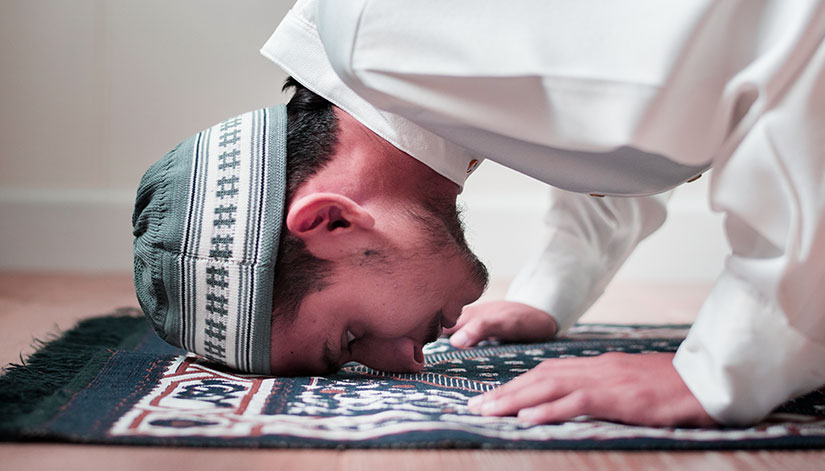
One of the five pillars of Islam is fasting, and during Ramadan, over 2 billion healthy, adolescent Muslims globally, are required to refrain from eating, drinking, and engaging in smoking, having sexual relations, basically indulging in any sensory pleasures. From sunrise to sunset for a duration of 29 or 30 days which they call the lunar month, they do this fast. The length of the daily fast is determined by the season and geographic location, as daylight lasts approximately 18-20 hours in midsummer and less than 6 hours in winter in Europe.
There is a great deal of cultural variation in the food habits of people who observe Ramadan around the world. It follows dietary preferences that are unique to a culture or the nation. For instance, in Ghana, during Ramadan, people consume more milk and fruits high in vitamin A, but less vegetables, and nuts. Additionally, the consumption patterns of meat stays largely unchanged in comparison to that of poultry.
The traditional Ramadan fast is one large meal after sunset and one smaller meal before dawn; however, one may have an extra meal occasionally consumed before sleeping. Both food and water consumption are only done after nightfall. It’s intriguing to note that Alternate-day fasting and Ramadan fasting are somewhat comparable, in that a 12-hour feast follows the 12-hour fast. But unlike alternate-day fasting, Ramadan fasting prohibits drinking water during the entire 12-hour fast.
During the month of Ramadan, there are instances in which body mass and BMI can rise. This is most likely caused by excess fat, glucose, or energy intake in addition to greater sedentary behaviour.
Japanese:

Fasts were first used as a three-day punishment for the Buddhist sin of eating meat during the Heian Period. The elite Buddhists considered eating any kind of meat, other than seafood, to be a kind of spiritually perverted behaviour. Because of the heavy Buddhist influence, Emperor Tenmu outlawed the consumption of domestic animals from the beginning of April till the end of September back in 675 A.D. Hunting was permitted, however. But of course, there was frequent violation of these laws.
In the Kamakura Period, more severe penalties had been put in place, including a decree from the Ise Shrine to refrain from eating, for a full 100 days if one were to consume any of the previously mentioned domestic or wild animals. If you shared a meal with an individual who had consumed “meat” you would also have to observe a 21-day fast.
So as you can see, since ancient times, fasting has been a fundamental component of Buddhism in Japan. There is also the austere traditional ritual known as Danjiki, which entails fasting, prayer, and rigorous workouts. Enlightenment necessitates a great deal of mind and bodily discipline in order to integrate the body, the mind, and the spirit into one. There have been many different types of Danjiki rituals in recent years. These include 2–3 days of fasting, carried out at a hotel under medical oversight, as well as a week or longer period of fasting and exercise protocols carried out at a Buddhism temple.
Conclusion:
The religious fasts discussed in this article show how crucial a high-quality diet is towards producing positive health outcomes. However, it seems that the food choices made by those who fast during this time period also have a significant impact on whether or not they experience positive health outcomes. This is not to argue that dietary intake is unimportant to health; but, numerous studies have shown the benefits of limiting kcal intake. Instead, these religious fasts serve as a reminder that it is possible to improve one’s diet without having to cut back on food choices.
Many different faiths base their religious practices heavily on diet. This function is exhibited by specific fasting times for a number of religions. Fasting based on faith, can greatly enhance one’s physical health and bring about a period of significant spiritual growth. The article emphasises how various religious fasts can be used to alter one’s diet. It should serve as an inspiration for the planning and execution of religious fasting for health, if you are planning to do so in the future.

